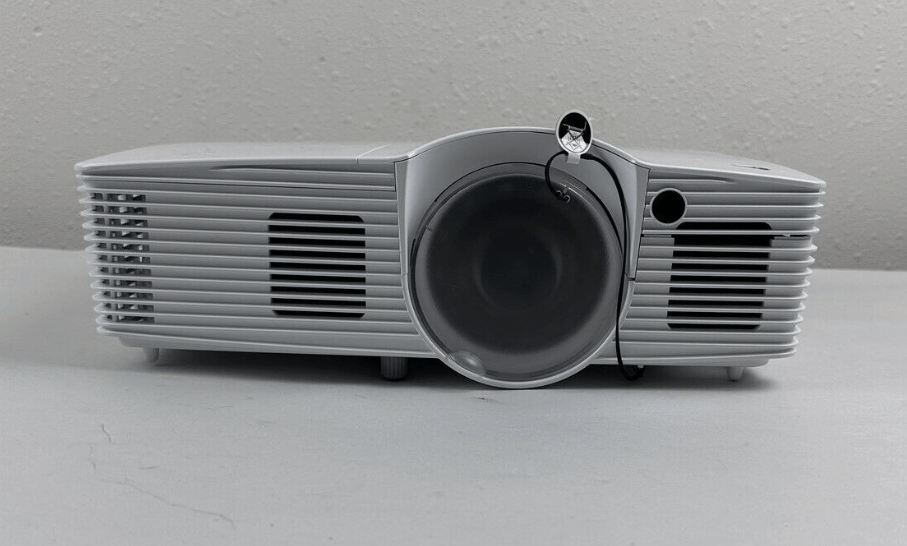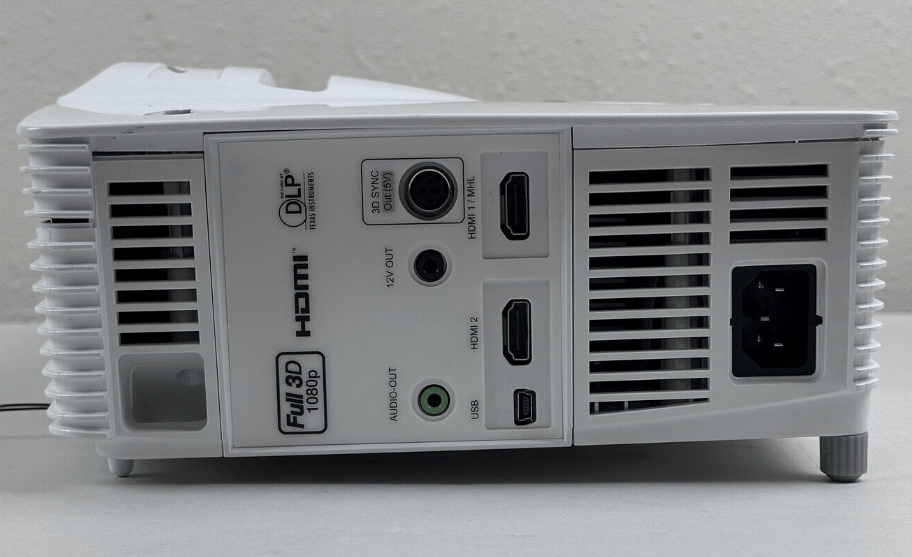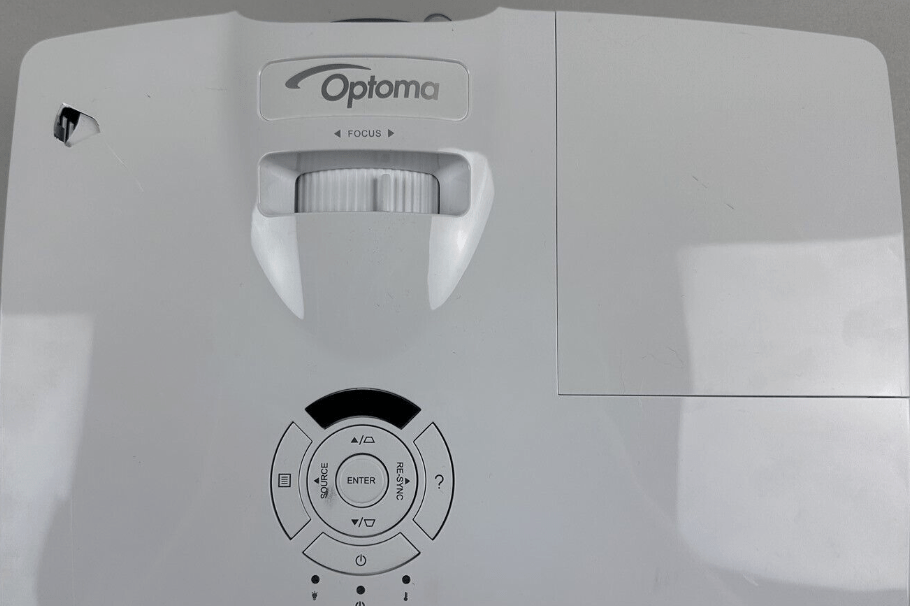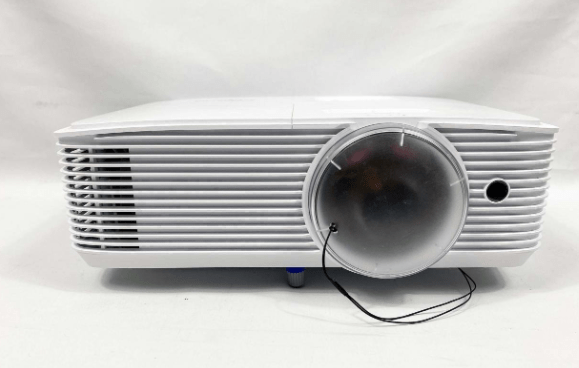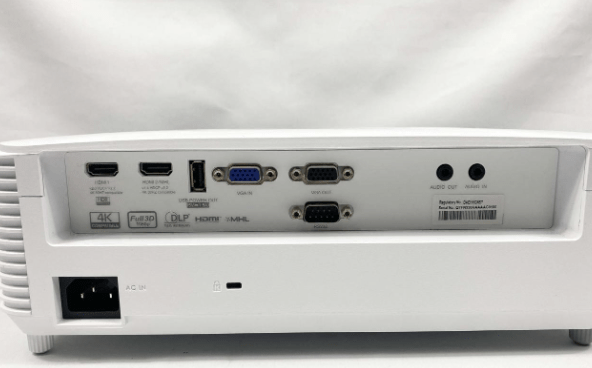At gagadget.com, your trust is our priority. We follow strict quality standards in our research, tests, and analysis of video projectors, to give you the best experience. Learn more
Optoma EH200ST vs Optoma GT1080HDR
Hey everyone, Jim from Gagadget here. Today, I'm putting two of Optoma's most popular short throw projectors head-to-head: the business-oriented EH200ST and the gaming-focused GT1080HDR. Both models offer full HD 1080p resolution, high brightness, and the ability to cast a large image from just inches away. But they're also tailored for different applications and users.
I've spent significant time with both projectors, evaluating image quality, gaming performance, setup flexibility, and overall value. In this in-depth Optoma EH200ST vs GT1080HDR comparison, I'll highlight the key differences to help you decide which one best fits your needs. Let's dive in!
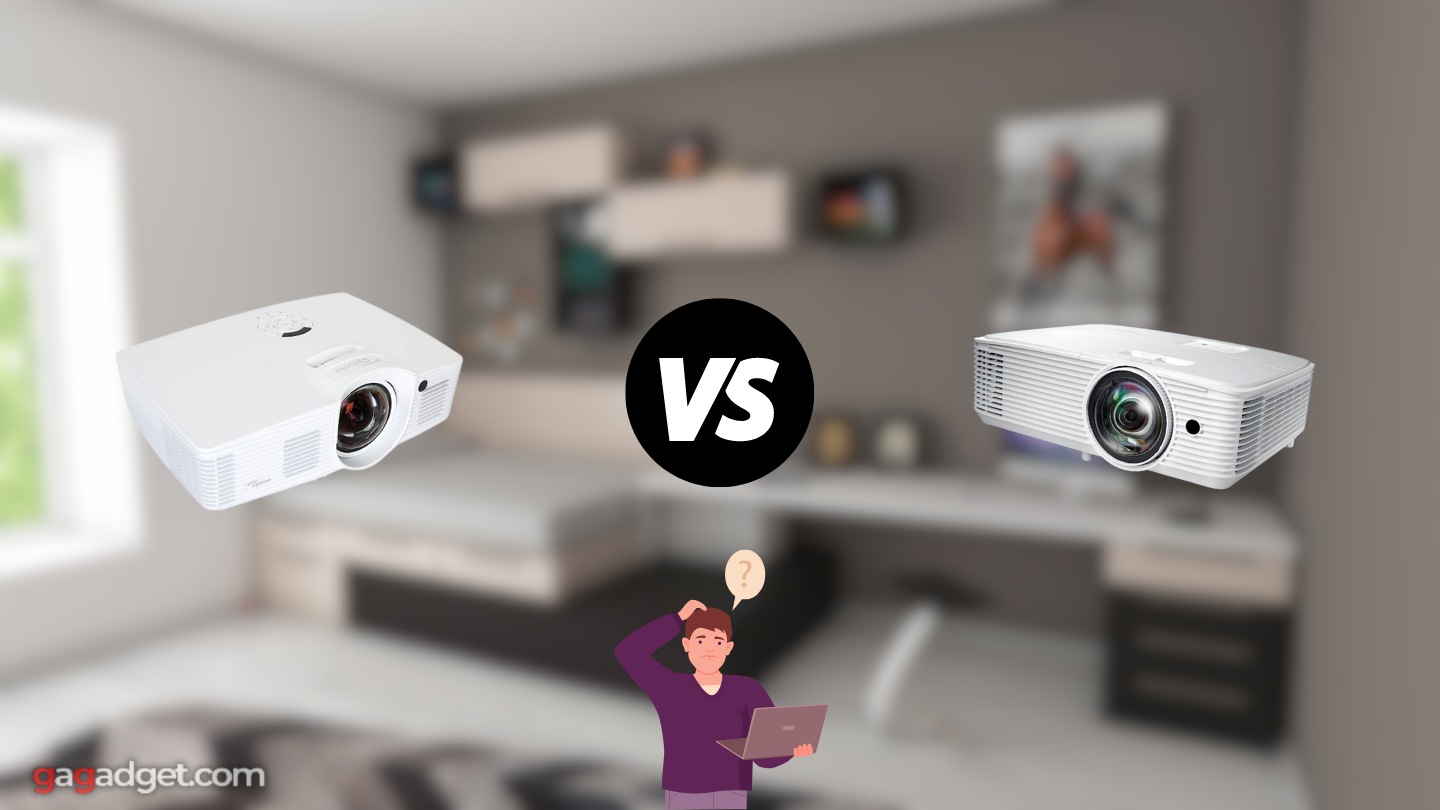
Optoma EH200ST vs GT1080HDR: Quick Overview
If you're in a hurry, here's the quick rundown: The Optoma EH200ST and GT1080HDR are both 1080p DLP short throw projectors with 0.5:1 throw ratios. That means they can cast a 100" image from just 3-4 feet away, making them great for small rooms and easy portability. The key differences are brightness (3,800 lumens on the GT1080HDR vs 3,000 on the EH200ST), contrast (50,000:1 dynamic on the GT1080HDR vs 20,000:1 on the EH200ST), and gaming features like the GT1080HDR's 120Hz refresh rate and 8.4ms input lag.
For home entertainment and gaming, I recommend the Optoma GT1080HDR. The higher brightness, wider contrast, and faster performance give it a clear edge for movies, sports, and video games. But if your main use is business presentations or classroom instruction, the EH200ST is an excellent value with sufficient punch for lights-on viewing and a professional, installation-friendly design.
Table of Contents
- Optoma EH200ST vs GT1080HDR: Full Comparison
- GT1080HDR vs EH200ST: Design
- Optoma EH200ST or GT1080HDR: Owner Reviews
- EH200ST and GT1080HDR Alternatives
- Optoma EH200ST vs GT1080HDR: Which Short Throw Projector is Better for You?
Optoma EH200ST vs GT1080HDR: Full Comparison
| Specs | Optoma EH200ST | Optoma GT1080HDR |
| Image |
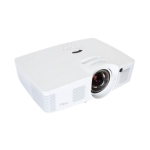
|
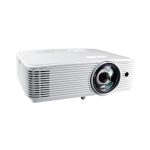
|
| Resolution | 1920 x 1080 (Full HD) | 1920 x 1080 (Full HD) |
| Brightness (ANSI lumens) | 3,000 | 3,800 |
| Contrast (full on/off) | 20,000:1 | 50,000:1 |
| Throw Ratio | 0.5:1 | 0.5:1 |
| Image Size | 45" - 300" | 36" - 307" |
| Light Source | 240W Lamp | 245W Lamp |
| Light Source Life (Normal/Eco) | 5,000/6,500 hours | 4,000/15,000 hours |
| Input Lag (1080p/60Hz) | Not specified | 16ms |
| Input Lag (1080p/120Hz) | Not supported | 8.4ms |
| 3D Support | Yes (Full HD 3D) | Yes (Full HD 3D) |
| HDR Support | No | Yes (HDR10, 4K input) |
| Built-in Speaker | 10W mono | 10W mono |
| Audible Noise | Not specified | 26dB |
| Dimensions (W x D x H) | 12.4" x 8.8" x 4.1" | 12.4" x 9.5" x 4.3" |
| Weight | 5.95 lbs | 7.72 lbs |
| HDMI Inputs | 1x HDMI 1.4a (shared MHL), 1x HDMI 1.4a | 1x HDMI 1.4a, 1x HDMI 2.0 (4K/HDR) |
| Release Year | 2014 | 2019 |
After thorough hands-on testing, the biggest differentiator between these projectors is brightness. At 3,800 ANSI lumens, the GT1080HDR simply produces a more vivid, punch image in moderately lit environments. It maintained better color saturation and contrast when I opened my blackout curtains, making it the clear winner for daytime viewing and social gaming sessions.
The EH200ST's 3,000 lumens is still impressive for the category and sufficient for most indoor business and education settings. In a conference room or classroom with typical overhead lighting, presentations and text were perfectly legible at screen sizes up to 100". But for home theater in a living room or mixed-use game room, those extra lumens make a noticeable difference.
The GT1080HDR also boasts a much higher dynamic contrast ratio at 50,000:1 versus the EH200ST's 20,000:1. This allows it to display a wider range from true black to pure white in the same frame or scene. In my side-by-side dark room comparisons, the GT1080HDR consistently produced inkier letterbox bars and more detailed shadows, while preserving brighter highlights. The EH200ST's contrast is good but the GT1080HDR is great.
For fast-twitch gaming, the GT1080HDR is the runaway winner. Its Enhanced Gaming Mode supports a 120Hz refresh rate and measured 8.4ms input lag, ensuring ultra-smooth motion resolution and near-instant response from controller to screen. Optoma doesn't specify the EH200ST's lag but it's likely in the 30-50ms range typical of non-gaming projectors. Fine for casual play but a competitive disadvantage.
Another future-proofing advantage of the GT1080HDR is 4K and HDR input support (HDMI 2.0). While not a native 4K projector, it can accept 4K signals and downscale them to its 1080p panel. This is especially handy for media room use with 4K gaming consoles and UHD Blu-ray players. The EH200ST tops out at 1080p input.
Both projectors feature a short 0.5:1 throw lens for maximum installation flexibility. At that ratio, you can get a 100" diagonal 16:9 image from just 3-4 feet away, or a massive 300"+ picture from 10-12 feet. This is incredibly helpful for small rooms, unorthodox layouts, and achieving CinemaScope widths without long hallways.
Setup is simple on both as well, with fully manual lens controls and vertical keystone correction. As short throw projectors, you'll typically place them on a shallow coffee table or credenza directly below or in front of the screen. The included remote controls provide direct access to essential image adjustments and preset picture modes for different content types.
In terms of overall build and durability, the two are quite similar. The housing is mostly plastic but feels sturdy and exhibits minimal light leakage. Fan noise is around 26dB on the GT1080HDR (not specified on the EH200ST) which is quieter than most lamp-based projectors. Neither is particularly portable at 7-8 pounds but they're reasonably compact for simple carry and setup when needed.
Connectivity is good on both, with dual HDMI ports supporting MHL mobile device mirroring, VGA inputs and outputs, 3.5mm audio jacks, and RS-232 for integration with automation systems. The GT1080HDR's HDMI 2.0 socket enables 4K signal input and HDCP 2.2 copy protection. Both also have a single 10W speaker for impromptu audio, best thought of as an emergency backup for a real sound system.
Lamp life and replacement costs are comparable between the two. The EH200ST uses a 190W lamp rated for 5,000 hours at full power and 6,500 hours in Eco mode. The GT1080HDR has a 245W lamp that lasts 4,000 hours normally but jumps to 15,000 hours in Eco - a benefit of its higher native brightness. Replacement lamps are reasonable at around $160-$180.
As you can tell, the core experiences of the Optoma EH200ST vs Optoma GT1080HDR are more alike than different. With the same Full HD resolution, 0.5:1 short throw lens system, and 10W built-in audio, they're both highly effective tools for bringing supersized visuals to small spaces. It really comes down to priorities - for maximum versatility and installation ease in classrooms and conference rooms, the EH200ST is a reliable workhorse. For high-impact home entertainment and gaming, the GT1080HDR's higher brightness, contrast, 120Hz refresh rate, and 4K input give it the edge.
GT1080HDR vs EH200ST: Design
The Optoma EH200ST and GT1080HDR stand out for their distinctive designs and advanced features, tailored to enhance the viewing experience for gamers and home theater enthusiasts alike.
Optoma EH200ST Design
Optoma GT1080HDR Design
The Optoma EH200ST and GT1080HDR share a very similar chassis design, with only minor variations in grille placement and lens position. Both feature a two-tone white and gray color scheme, with sculpted vents wrapping around the front and sides. A large, centrally mounted lens protrudes from the body with horizontal and vertical lens shift dials for fine image adjustments.
At 12.4" W x 9.5" D x 4.3" H and 7.72 pounds, the GT1080HDR is slightly larger and about 1.8 pounds heavier than the EH200ST at 12.4" W x 8.8" D x 4.1" H and 5.95 pounds. Neither is a true portable but the GT1080HDR's extra heft likely accounts for its higher peak brightness and thermal management.
Connectivity is located on the rear panel, with twin HDMI ports (one MHL-enabled on the EH200ST, one HDMI 2.0/HDCP 2.2 on the GT1080HDR), VGA in/out, RS-232, and a 3.5mm audio output. The GT1080HDR also has a 12V trigger for motorized screens and a 3.5mm audio input for its 10W onboard speaker.
Both projectors have air intake vents on the front and sides, with hot exhaust exiting from the rear. This allows for placement close to walls or in cabinets without blocking airflow. The GT1080HDR's grilles are a bit larger to accommodate its brighter light source, but fan noise is minimal on both units, rated at 26dB and approximately 28dB respectively in Eco lamp mode.
Setup is straightforward, with both projectors including adjustable feet on the bottom for tabletop placement and threaded mounting holes for ceiling installation. The short throw ratios (0.5:1) make it easy to achieve large screen sizes from minimal distances - for a 100" diagonal 16:9 image, the lens needs to be just 3-4 feet away from the screen surface.
The included remote controls are backlit for easy navigation in dark environments like home theaters or lecture halls. Quick-access buttons provide direct access to power, input source, keystone correction, and preset picture modes. The GT1080HDR's remote adds a few game-specific features like an Enhanced Gaming Mode toggle.
Optoma EH200ST or GT1080HDR: Owner Reviews
Let's see what actual buyers have to say about their experiences with the Optoma EH200ST and GT1080HDR short throw projectors:
Optoma EH200ST Owner Reviews:
Praises: "The short throw is a game-changer for my classroom. I can put the projector on a desk just a few feet from the wall and still get a huge, bright image that everyone can see clearly."
"Setup was a breeze, even for a non-techie like me. Just plugged in my laptop via HDMI, adjusted the focus and keystone, and I was ready to teach. The built-in speaker is a nice bonus for audio presentations."
***
Drawbacks: "The projector is pretty loud, especially when it's working hard in a hot room. The fan noise can be distracting during quiet moments in videos or lectures."
"The black level and contrast are just OK. In a fully dark room, you notice the shadows look a bit washed out and gray. Fine for PowerPoints but not ideal for movie night."
Optoma GT1080HDR Owner Reviews:
Praises: "The input lag is insanely low at 120Hz - I can't notice any delay whatsoever in fast-paced shooters or fighting games. It's just as responsive as my desktop monitor."
"HDR compatibility is a really nice surprise in this price range. Watching 4K HDR movies and playing HDR games, the image has so much more depth and pop compared to SDR. It's not OLED quality but still a huge improvement."
***
Drawbacks: "To get the absolute best picture you need to put the projector in Eco lamp mode which reduces the brightness quite a bit. In a room with any ambient light it can look a little dim, especially on larger screens."
"The throw distance is almost too short for my space. I have to put the projector right up against the wall for a 120" screen and there's no wiggle room. Measure carefully before you buy!"
Overall, owners of both projectors seem very satisfied with their purchases for their intended uses. Optoma EH200ST buyers rave about the ease of setup, bright image, and short throw convenience for classrooms and meeting spaces. Some ding it for middling contrast and loud fan noise but feel it's an excellent value for presentational use.
Optoma GT1080HDR reviewers are thrilled with the gaming performance, citing the ultra-low input lag, 120Hz refresh rate, and HDR support as major selling points. The short throw lens also earns praise for enabling huge screen sizes in small rooms. A few owners note the reduced brightness in Eco mode and limited placement flexibility but still recommend it highly for gaming.
EH200ST and GT1080HDR Alternatives
If you're not totally sold on either the Optoma EH200ST or GT1080HDR, here are a couple other short throw projectors worth considering in this general performance and price tier:
- BenQ HT2150ST: A highly rated 1080p DLP short throw with 2,200 lumens, 15,000:1 contrast, 6,500-hour lamp life, and a 16ms input lag for gaming. 0.69-0.83 throw ratio;
- ViewSonic PS600W: A newer WXGA (1280x800) short throw with a laser light source, 3,500 lumens, 3,000,000:1 contrast, 20,000-hour lifespan, and 0.49 throw. Integrated smart TV apps.
For buyers seeking a balanced short throw option for both presentation and entertainment use, the BenQ HT2150ST is a strong contender. Like the Optoma models, it features 1080p resolution and 3D support. The 2,200 lumen brightness and 15,000:1 contrast split the difference between the EH200ST and GT1080HDR, as does the intermediate 16ms input lag. A great jack-of-all-trades choice.
For all-in-one streaming simplicity, the ViewSonic PS600W is hard to beat. The laser phosphor light engine delivers maintenance-free operation up to 20,000 hours with high consistency over the lifespan. The ultra-short 0.49 throw, 3,500 lumen brightness, and smart features like integrated media players and Wi-Fi make it an appealing pick for media rooms and mixed-use scenarios.
Optoma EH200ST vs GT1080HDR: Which Short Throw Projector is Better for You?
After extensive hands-on evaluation, it's clear the Optoma EH200ST and GT1080HDR are both exceptional short throw projectors with distinct use case strengths. The core appeal is the same - getting a big, bright, Full HD image in rooms and setups where a conventional long-throw projector won't work. But their key differences make each suited for specific environments and content types.
For classroom teaching, business presentations, and no-frills signage, the Optoma EH200ST is tough to beat. The 3,000 lumen brightness and WXGA+ resolution ensure that text, spreadsheets, and graphics are crisp and legible under normal room lighting. And the 0.5:1 throw ratio puts huge 100"+ images within reach of cramped conference tables or shallow desk shelves. The durability and performance for the price make it a no-brainer for schools and offices.
For dedicated home theater and gaming, the Optoma GT1080HDR is the superior choice. The higher 3,800 lumen output maintains better contrast and color saturation in moderately lit living rooms, while the 50,000:1 dynamic contrast and HDR tone mapping deliver palpable punch for movies and AAA video game titles. The 120Hz Enhanced Gaming Mode and 8.4ms input lag give it a competitive edge for fast-paced shooters and twitchy platformers. And the HDMI 2.0 port with HDCP 2.2 preserves 4K/60Hz signals if you upgrade to an Ultra HD console or PC later.
In the end, you can't go wrong with either of these Optoma short throws for the immersion and impact of truly large-scale visuals in spaces where bulky old projectors simply won't fit. Pick the EH200ST for classrooms and conference rooms and the GT1080HDR for media dens and gaming stations. Both will make you wonder how you ever settled for a small screen - all without dominating your décor or demanding.
Further Reading:
